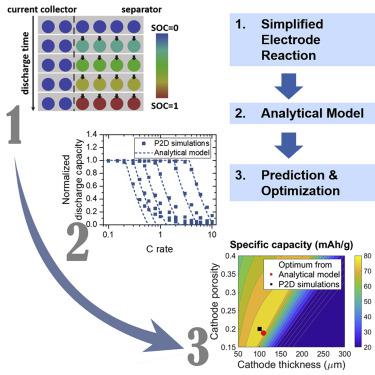Cell Reports Physical Science ( IF 7.9 ) Pub Date : 2020-09-16 , DOI: 10.1016/j.xcrp.2020.100192 Fan Wang , Ming Tang

|
The prediction of the performance of battery cells is usually accomplished by computationally expensive numerical simulations. Here, we present a simple analytical model as an efficient alternative to predict the rate capability of battery cells limited by electrolyte transport without the need to fit parameters to simulations. It exhibits very good agreement with simulations over a wide range of discharge rate and electrode thickness and offers a speedup of >105 times. The optimal electrode properties predicted by the model differ <∼10% from simulation results, suggesting it as an attractive computational tool for the cell-level design of batteries. The model reveals that the discharge capacities of half- and full cells exhibit qualitatively different scaling relations with electrode thickness and current density, and the rate performance of thick electrodes can be improved by avoiding electrode materials (e.g., LiFePO4, Li4Ti5O12) whose open-circuit potentials are insensitive to the state of charge.
中文翻译:

预测和优化单电池速率性能的定量分析模型
通常通过计算昂贵的数值模拟来完成对电池单元性能的预测。在这里,我们提出了一种简单的分析模型,作为预测受电解质运输限制的电池单元速率能力的有效替代方法,而无需将参数拟合到模拟中。它与各种放电速率和电极厚度的仿真显示出非常好的一致性,并提供了> 10 5的加速比次。该模型预测的最佳电极性能与模拟结果相差约10%,这表明它是用于电池单元级设计的有吸引力的计算工具。该模型表明,半电池和满电池的放电容量在质量上与电极厚度和电流密度成比例关系,并且通过避免使用电极材料(例如,LiFePO 4,Li 4 Ti 5 O)可以提高厚电极的倍率性能。12)其开路电势对电荷状态不敏感。











































 京公网安备 11010802027423号
京公网安备 11010802027423号